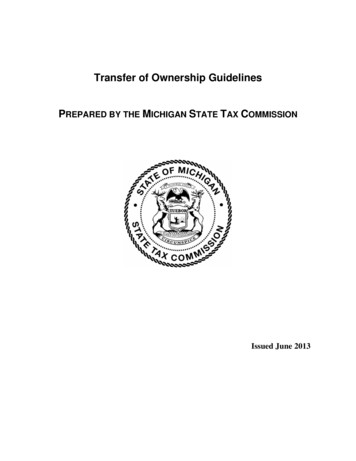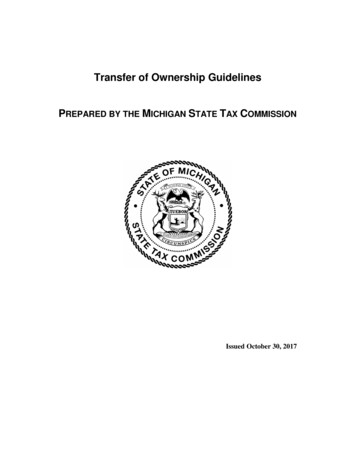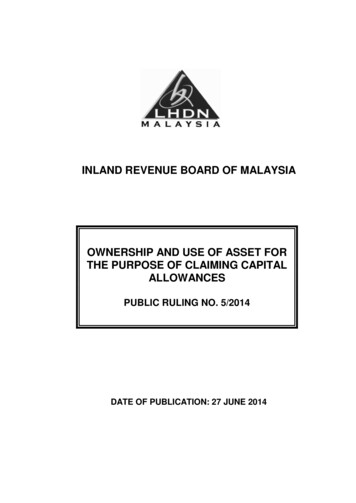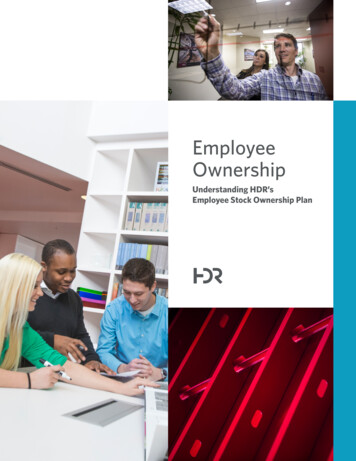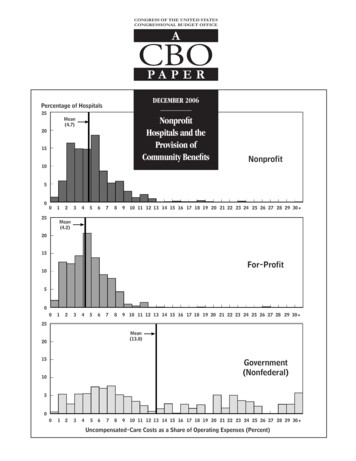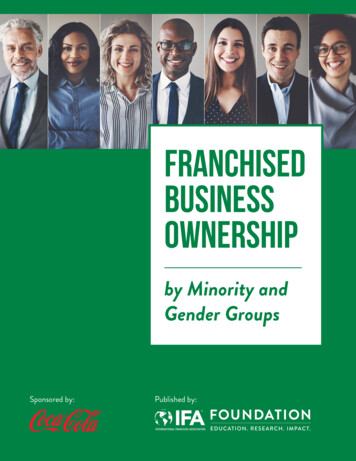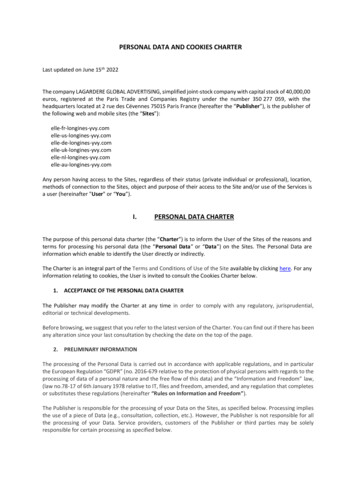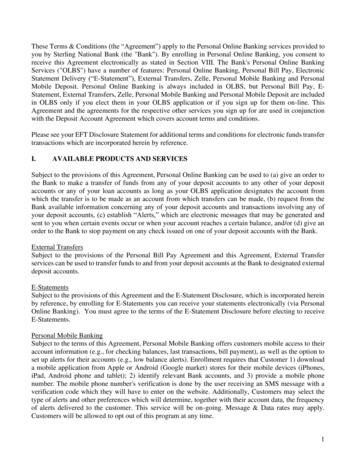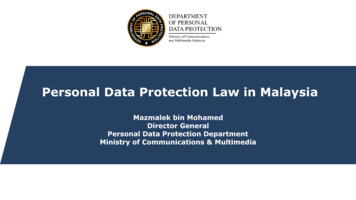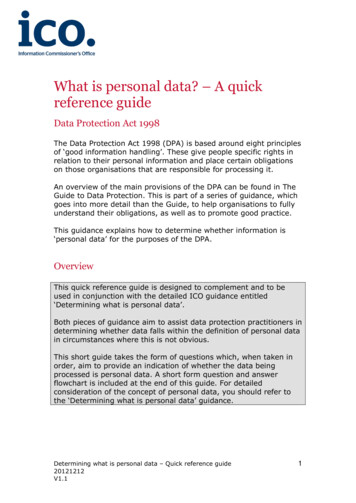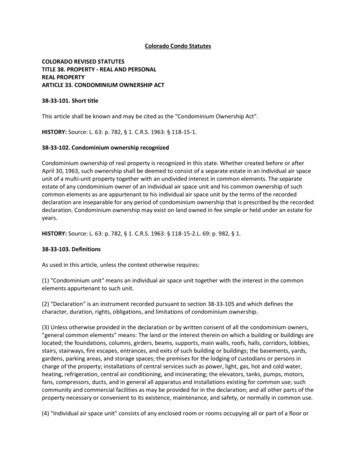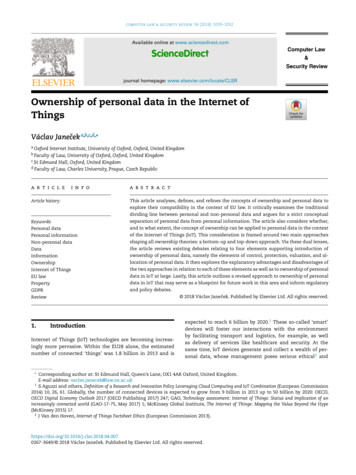
Transcription
computer law & security review 34 (2018) 1039–1052Available online at www.sciencedirect.comjournal homepage: www.elsevier.com/locate/CLSROwnership of personal data in the Internet ofThingsVáclav Janeček a,b,c,d, a OxfordInternet Institute, University of Oxford, Oxford, United Kingdomof Law, University of Oxford, Oxford, United Kingdomc St Edmund Hall, Oxford, United Kingdomd Faculty of Law, Charles University, Prague, Czech Republicb Facultya r t i c l ei n f oArticle history:a b s t r a c tThis article analyses, defines, and refines the concepts of ownership and personal data toexplore their compatibility in the context of EU law. It critically examines the traditionaldividing line between personal and non-personal data and argues for a strict conceptualKeywords:separation of personal data from personal information. The article also considers whether,Personal dataand to what extent, the concept of ownership can be applied to personal data in the contextPersonal informationof the Internet of Things (IoT). This consideration is framed around two main approachesNon-personal datashaping all ownership theories: a bottom-up and top-down approach. Via these dual lenses,Datathe article reviews existing debates relating to four elements supporting introduction ofInformationownership of personal data, namely the elements of control, protection, valuation, and al-Ownershiplocation of personal data. It then explores the explanatory advantages and disadvantages ofInternet of Thingsthe two approaches in relation to each of these elements as well as to ownership of personalEU lawdata in IoT at large. Lastly, this article outlines a revised approach to ownership of personalPropertydata in IoT that may serve as a blueprint for future work in this area and inform regulatoryGDPRand policy debates. 2018 Václav Janeček. Published by Elsevier Ltd. All rights reserved.Review1.IntroductionInternet of Things (IoT) technologies are becoming increasingly more pervasive. Within the EU28 alone, the estimatednumber of connected ‘things’ was 1.8 billion in 2013 and isexpected to reach 6 billion by 2020.1 These so-called ‘smart’devices will foster our interactions with the environmentby facilitating transport and logistics, for example, as wellas delivery of services like healthcare and security. At thesame time, IoT devices generate and collect a wealth of personal data, whose management poses serious ethical2 and Corresponding author at: St Edmund Hall, Queen’s Lane, OX1 4AR Oxford, United Kingdom.E-mail address: vaclav.janecek@law.ox.ac.uk1S Aguzzi and others, Definition of a Research and Innovation Policy Leveraging Cloud Computing and IoT Combination (European Commission2014) 10, 26, 61. Globally, the number of connected devices is expected to grow from 9 billion in 2013 up to 50 billion by 2020: OECD,OECD Digital Economy Outlook 2017 (OECD Publishing 2017) 247; GAO, Technology assessment: Internet of Things: Status and implication of anincreasingly connected world (GAO-17-75, May 2017) 1; McKinsey Global Institute, The Internet of Things: Mapping the Value Beyond the Hype(McKinsey 2015) 17.2J Van den Hoven, Internet of Things Factsheet Ethics (European Commission 67-3649/ 2018 Václav Janeček. Published by Elsevier Ltd. All rights reserved.
1040computer law & security review 34 (2018) 1039–1052legal3 questions. Ownership of personal data underpins theissues revolving around data management and control, suchas privacy, trust,4 and security, and it has also important implications for the future of the ‘digital’ economy and trade indata.5 This is why debates on introducing the concept of dataownership as a legal right have recently emerged at the EUlevel6 and beyond,7 and why they are still thriving, althoughthe majority of the legal doctrine and now also the European3See J Drexl and others, ‘Data Ownership and Access to Data– Position Statement of the Max Planck Institute for Innovationand Competition of 16 August 2016 on the Current European Debate’ (2016) Max Planck Institute for Innovation & Competition ResearchPaper No 16-10 https://ssrn.com/abstract 2833165 accessed 16November 2017.4M Taddeo, ‘Trusting Digital Technologies Correctly’ (2017) 27Minds & Machines 565; M Taddeo, ‘Trust in Technology: A Distinctive and a Problematic Relation’ (2010) 23 Know Tech Pol 283.5See, e.g., TJ Farkas, ‘Data Created by the Internet of Things: TheNew Gold without Ownership’ (2017) 23 Rev Prop Inmaterial 5, 14;C Bartolini, C Santos and C Ullrich, ‘Property and the cloud’ (2018)34 CLSRev 358; V Gazis and others, ‘Short Paper: IoT: Challenges,projects, architectures’ (2015) 18 International Conference on Intelligence in Next Generation Networks 145; A Whitmore, A Agarwal and L Da Xu, ‘The Internet of Things—A survey of topics andtrends’ (2015) 17 Inf Syst Front 261, 266; IERC – European ResearchCluster on the Internet of Things, Internet of Things: IoT governance,privacy and security issues (European Commission 2015) 10, 78–79.6See, e.g., Commission, ‘Building a European Data Economy’(Communication) COM (2017) 9 final, 9–10, 13; Commission,‘On the free flow of data and emerging issues of the Europeandata economy, accompanying COM (2017) 9 final’ (CommissionStaff Working Document) SWD (2017) 2 final, esp. 23, 33–38;Osborne Clarke LLP, Legal study on ownership and access to data(European Commission 2016) https://bookshop.europa.eu/en/legal- study- on- ownership- and- access- to- data- pbKK0416811/ [https://perma.cc/82D8-9787]; N Duch-Brown, B Martensand F Mueller-Langer, ‘The Economics of Ownership, Access and Trade in Digital Data’ (JRC Digital EconomyWorking Paper 2017-01, European Commission 2017) 12ff 56.pdf [https://perma.cc/NUM8-HVWB]; A Gärtner and K Brimsted,‘Let’s talk about data ownership’ (2017) 39 EIPR 461; S van Erp,‘Ownership of Data: The Numerus Clausus of Legal Objects’ (2017)6 Brigham-Kanner Property Rights Conference Journal 235; SLohsse, R Schulze and D Staudenmayer (eds), Trading Data in theDigital Economy: Legal Concepts and Tools (Nomos/Hart Publishing2017); F Thouvenin, RH Weber and A Früh, ‘Data ownership: Takingstock and mapping the issues’ in M Dehmer and F Emmert-Streib(eds), Frontiers in Data Science (CRC Press 2018). Thanks is due toStephen Saxby for bringing my attention to the 2018 publication.7Globally, see, e.g., IEEE Global Initiative on Ethics of Autonomous and Intelligent Systems, Ethically Aligned Design:A Vision for Prioritizing Human Well-being with Autonomous andIntelligent Systems (version 2) (IEEE 2017) 141–42, 237–38, 247[https://perma.cc/W5MT-VK9K]; McKinsey Global Institute (n 1)11, 26, 104, 106, 107 and 113. For India, see Telecom RegulatoryAuthority of India, Consultation Paper on Privacy, Security and Ownership of the Data in the Telecom Sector (TRAI Consultation No 09/2017)2 and 6 [https://perma.cc/ES29-ZVA4]. Thanks is due to AshokRajagopalan for bringing my attention to this Indian document.For Australia, see Productivity Commission, Data Availability andUse (Report No 82, 2017) 53, 65, 66, 177, 191, 196, 241 and 584[https://perma.cc/6RKE-PCGL]. For China, see Arts 45 and 48 ofthe First Draft E-Commerce Law of the People’s Republic of China(published 27 December 2016). Thanks is due to Vicky Cheng forbringing my attention to this Chinese document. For the USA, seeCommission have reservations about the data ownership concept.Due to legal developments in personal data protection,starting with the fundamental right to respect for private life,8over the fundamental right to protection of personal data,9and recently culminating by the data subject’s rights grantedby the General Data Protection Regulation (GDPR),10 it became impossible to think of any data ownership without alsothinking about ownership of personal data. The problem is,however, that the line between personal and non-personaldata is a moving target and data that are now seen as nonpersonal data may become (thanks to analytical and technological advancements) personal data in the future.11 Thus, exploring the conceptual limits of ownership of personal datamust precede debates on ownership of purely non-personaldata (e.g. data employed in smart farming).12 In fact, personaldata have already been recognized as one of the key economic assets,13 and avoiding questions regarding their ownership is thus problematic even in the light of these economictrends. Moreover, the need for the analysis stems from thenature of the IoT world in which many of us already live.Take, for instance, ‘smart cities’ where big data companiesmay soon be able to privatize data (including personal data),despite them being largely collected without prior consent ofdata subjects.14 In response to these challenges, a number ofownership-like types of technological solution are also emerging. One such example is the AURA platform—a Personal InOsborne Clarke LLP (n 6) 78–81. For the United Kingdom (if seenas a potential non-EU member), see http://www.parliament.uk/business/lords/media- centre/house- of- lords- media- notices/house- of- lords- media- notices- 2017/october- 2017/who- shouldown- your- data/ [https://perma.cc/73JB- 8QJU].8Art 8 of the Convention for the Protection of Human Rights andFundamental Freedoms 1950.9Art 8 of the Charter of Fundamental Rights of the EuropeanUnion [2012] OJ C326/391.10Regulation (EU) 2016/679 of the European Parliament and of theCouncil of 27 April 2016 on the protection of natural persons withregard to the processing of personal data and on the free movement of such data, and repealing Directive 95/46/EC (General DataProtection Regulation) (OJ L 119/2016).11C Wendehorst, ‘Of Elephants in the Room and Paper Tigers:How to Reconcile Data Protection and the Data Economy’ inLohsse, Schulze and Staudenmayer (eds) (n 6) 332.12See S Wolfert and others, ‘Big Data in Smart Farming – A review’ (2017) 153 Agricultural Systems 69; J Drexl, ‘Designing Competitive Markets for Industrial Data – Between Propertisation andAccess’ (2017) 8 JIPITEC 257. cf also Commission, ‘Proposal for aRegulation of the European Parliament and of the Council on aframework for the free flow of non-personal data in the EuropeanUnion’ COM (2017) 495 final; Commission, ‘Proposal for a Regulation of the European Parliament and of the Council concerning therespect for private life and the protection of personal data in electronic communications and repealing Directive 2002/58/EC (Regulation on Privacy and Electronic Communications)’ COM (2017) 10final.13World Economic Forum, Personal Data: The Emergence of a NewAsset Class (Geneva 2011) http://www3.weforum.org/docs/WEFITTC PersonalDataNewAsset Report 2011.pdf [https://perma.cc/T7JL-BZXK].14See L Edwards, ‘Privacy, Security and Data Protection in SmartCities: A Critical EU Law Perspective’ (2016) 2 EDPLR 28, 29, 33–34.
computer law & security review 34 (2018) 1039–1052formation Management system (PIM)15 —which was recentlyintroduced by Telefónica in Spain and which, in contrast withtrends in the smart cities, allows end-users to control relevant data that their mobile operator holds about them (e.g.the user’s geolocation) and to decide with whom these datawill be shared.16In this article, I analyse, define, and refine the concepts ofownership and personal data to bring existing debates aboutownership of personal data to common ground (Section 2).Then, I review theories of ownership and reasons supporting ownership of personal data to consider whether, and towhat extent, the concept of ownership can be applied to personal data in IoT. My analysis is framed around two mainapproaches shaping all ownership theories: a bottom-up andtop-down approach. I contrast these two approaches by looking at whether stabile ownership is yet to be created by positive law (the top-down approach) or whether positive law ismeant to stabilize already existing, though instable, de factoownership (the bottom-up approach). Via these dual lenses, Ireview reasons explaining and justifying propertisation of personal data in IoT as well as reasons supporting to whom thesedata should belong. My aim is to unveil the advantages anddisadvantages of the two approaches and to frame the existing debates (Section 3). To show potential directions for consistent and sustainable policies and law-making in this regard,I outline a revised approach to ownership of personal data thatmay serve as a blueprint for developing this intellectual structure, should it be introduced in the first place (Section 4). Finally, I conclude that—in the context of the EU law—either arevised bottom-up approached ownership theory is needed ordata ownership initiatives are to be, at least partially, repealed(Section 5).Lastly, a terminological point needs to be made. In this article, I use the phrase ‘ownership of personal data’, because theexpression ‘personal data ownership’, albeit stylistically moreelegant, invites unclear and biased thinking by signalling thatthe personal data should be owned personally by the data subject. The desired allocation of ownership, however, is yet to beexplored in this paper.15European Data Protection Supervisor, ‘EDPS Opinion onPersonal Information Management Systems’ (Opinion No9/2016) /16- 10- 20 pims opinion en.pdf [https://perma.cc/X236-GR48].16Telefónica, ‘Telefónica presents AURA, a pioneeringway in the industry to interact with customers basedon cognitive intelligence’ (press release, 26 February2017) https://www.telefonica.com/en/web/press- office/- /telefonica- presents- aura- a- pioneering- way- in- the- industry- tointeract- with- customers- based- on- cognitive-intelligence [https://perma.cc/F59Q-LV74]. In 2018, the platform shall belaunched also in Germany, the UK, Brazil, Argentina and Chile,possibly expanding to 11 markets by 2020 (Telefonica to launchAura AI platform in 6 markets in February (telecomaper news,30 November 2017) https://www.telecompaper.com/news/telefonica- to- launch- aura- ai- platform- in- 6- markets- in- february–1222638 [https://perma.cc/EES2-YM2M]).10412.The concepts of ownership and personaldata in the context of European law2.1.OwnershipSince the concept of ownership is not defined at the EU-lawlevel,17 and since national legal systems define ownership differently, I first conceptually canvass a minimal definition ofownership. From a comparative viewpoint, a main distinctioncan be drawn between the civil law and common law understanding of ownership.18 The civil law recognizes a limitednumber of property rights and a limited number of legal objects that can be subjected to these property rights (the socalled numerus clausus).19 In contrast, the common law is moreflexible and allows private parties more freedom in the typesof ownership interests which they can create.20 Therefore, thecivilian idea of ownership is an absolute dominion encompassing all the listed rights (numerus clausus) over the relevantobject; whereas in the common law tradition, ownership includes a variety of different rights over the same property. Incommon law, therefore, ownership can be gradual: you canhave more or less ownership depending on how large the bundle of your property rights in the object is. To overcome thiscivil law/common law divide and to avoid conceptual issuesstemming from the debate about the nature of ownership,21I refer to ownership as to a full-ownership, i.e. a bundle of allproperty rights. Such working definition can be acceptable inboth legal traditions.The second important comparative observation is that thecivil law considers ownership an absolute right erga omnes, i.e.a right that gives rise to legal protection of property againsteveryone, whereas common law recognizes personal propertyrights (in personam) and real property rights (in rem) of whichonly the latter are exigible against the entire world.22 This iswhy common lawyers can conceive of ownership of personaldata as giving the owner a legal protection both relative toa particular person (ownership rights in personam) and absolutely against everyone (ownership rights in rem).23 To clearthe ground for analysing ownership of personal data in IoTin Europe, I proceed with an absolute concept of ownershipto accent the common erga omnes/in rem feature of ownership17See more in S van Erp and B Akkermans, ‘European Union property law’ in C Twigg-Flesner (ed), The Cambridge Companion to European Union Private Law (CUP 2010) 173.18See U Mattei, Basic Principles of Property Law: A Comparative Legaland Economic Introduction (Greenwood Press 2000) ch 1; M Graziadei,‘The structure of property ownership and the common law/civillaw divide’ in G Michele and S Lionel (eds), Comparative PropertyLaw: Global Perspectives (Edward Elgar Publishing 2017).19van Erp (n 6) 235; B Akkermans, The Principle of Numerus Claususin European Property Law (Intersentia 2008); J Gordley, Foundations ofPrivate Law: Property, Tort, Contract, Unjust Enrichment (OUP 2006) 49.20Gordley (n 19) 49; van Erp (n 6) 236.21A Ross, ‘Tû-Tû’ (1957) 70 HarvLRev 812; JR Pennock and JWChapman, Property (New York UP 1980). More recently, e.g., J Waldron, ‘“To Bestow Stability upon Possession” – Hume’s Alternativeto Locke’ in J Penner and HE Smith (eds), Philosophical Foundationsof Property Law (OUP 2013).22Gordley (n 19) 49; Mattei (n 18) 8–9.23C Rees, ‘Who owns our data?’ (2014) 30 CLSRev 75, 77–78.
1042computer law & security review 34 (2018) 1039–1052in both main European legal traditions. Besides, the EuropeanCommission used the same understanding of ownership withregard to data in its communication from 2017,24 which further justifies my restrictive interpretation of the term.Conceptually, then, ownership entails four elements thatjointly answer the ‘Who owns what?’ question—an elementof control, protection, valuation, and allocation of a resource.Let me explain this idea. Ownership rights have an active andpassive aspect, giving the owner full-blown active control orfull-blown passive protection of the resource. These active andpassive rights relate to a valuable object, i.e. an object that isworth controlling and protecting. Thus, when the law guarantees a full-blown erga omnes/in rem control and protectionover a valuable resource, we can speak of propertisation ofthe resource—the resource turns into property. Subsequently,it becomes necessary to allocate such property to someone. InSection 3, I analyse all four elements to explore why the lawshould allow someone to control and protect personal data,and to whom these valuable data should be allocated.2.2.Personal dataPersonal data are now legally defined in Article 4(1) of theGDPR as follows:‘[P]ersonal data’ means any information relating to anidentified or identifiable natural person (‘data subject’) [ ].This definition illustrates the slippery language regardingpersonal data. On one hand, the GDPR, Recital 68 explicitlywants to ‘strengthen the [natural person’s] control over hisor her own data’ (emphasis added), thereby making a step towards ‘data subjects’ default ownership of their personal data’.25On the other hand, personal data are also referred to in theGDPR as ‘personal information’26 or simply as ‘information’27 relating to a natural person. This understanding, however, overlooks the conceptual distinction between data and information and has crucial implications when it comes to ownershipof personal data as opposed to ownership of personal information.Data and information are two distinct concepts. Imagine astone containing Egyptian hieroglyphs. Until the discovery ofthe Rosetta Stone, the very same piece of writing would represent all the data, but convey no meaningful information toits reader.28 Data can be defined as ‘putative fact[s] regardingsome difference or lack of uniformity within some context’.29In the given scenario, data are represented by the hieroglyphs24Commission, ‘On the free flow of data ’ (n 6) 33.Recital 68 of the GDPR (emphasis added). See also Recital 7 ofthe GDPR.26Recital 6 of the GDPR (emphasis added).27Art 4(1) of the GDPR (emphasis added). See also Article 29 DataProtection Working Party, ‘Opinion 4/2007 on the Concept of Personal Data’ (WP 136, 20 June 2007).28This example is taken from L Floridi, ‘Is Semantic InformationMeaningful Data?’ (2005) 70 Philosophy and Phenomenological Research 351, 359.29L Floridi, ‘Semantic Conceptions of Information’, The Stanford Encyclopedia of Philosophy (Spring edn, 2017) s/information-semantic/ accessed 15 November 2017.25and as such they are the source of information, depending onhow we interpret them. There is thus no data-less information. This means that we need not to understand the information that any data may convey in order to treat the data asan asset from which valuable information may be extracted inthe future.In debates on data ownership, however, a clear conceptual distinction between data and information is missing.30The legal debates build on a related yet conceptually very distinct differentiation between the form (usually digital form) inwhich information is embodied and the meaning containedin that form (information itself). This difference has recentlybeen described as a distinction between the syntactic level ofinformation (the form) and the semantic level of information(the meaning).31 For the purposes of discussing data ownership, this approach cannot bring the desired level of clarity,though, because it confuses syntactic information with data.The confusion between the syntactic level of information (as a formal representation of information) and the data(as a source of identical information) originates from aninformation-centred starting point of these legal debates. Theoriginal question featuring in said debates was ‘When information (not data) can be protected by the law?’ and the answerwas that while semantic information (i.e. information per se)can never be protected by the law because it would violate freeaccess to information,32 syntactic information can be given legal protection.33 From the information-centred viewpoint thisanswer was satisfactory. Saying that syntactic information ormore precisely the formal expression of information, for example in form of a digital sequence of data, can be legally protected addressed the relevant information-centred problem.The data-centred discourse, however, cannot make efficientuse of this conceptual scheme, because its original questionsare ‘How can we protect data?’ and ‘What information can beextracted from data?’, not ‘How can we express some information in form of (e.g. digital) data?’.The fact that the same data can be analysed in indefiniteways also gave rise to the concern that data collected in IoTenvironments may eventually reveal sensible personal information. Some argue that the same piece of data can be interpreted as substantiating both personal and non-personalinformation depending on the context and purpose of its use,30See, e.g., G Malgieri, ‘Property and (Intellectual) Ownership ofConsumers’ Information: A New Taxonomy for Personal Data’(2016) 4 Privacy in Germany 133; N Purtova, ‘Property in PersonalData: Second Life of an Old Idea in the Age of Cloud Computing,Chain Informatisation, and Ambient Intelligence’ in S Gutwirthand others (eds), Computers, Privacy and Data Protection: An Elementof Choice (Springer Netherlands 2011) 39; N Purtova, ‘Property rightsin personal data: Learning from the American discourse’ (2009) 25CLSRev 507, 507; N Purtova, Property Rights in Personal Data: A European Perspective (Wolters Kluwer Law & Business 2012) 129; Gärtner and Brimsted (n 6) 464; Rees (n 23); van Erp (n 6) 247, 251; A DeFranceschi and M Lehmann, ‘Data as Tradeable Commodity andNew Measures for their Protection’ (2015) 1 Italian LJ 51, 51–52.31Commission, ‘On the free flow of data ’ (n 6) 34; Lohsse,Schulze and Staudenmayer (eds) (n 6); H Zech, ‘Information asProperty’ (2015) 6 JIPITEC 192; Thouvenin, Weber and Früh (n 6)120–21.32van Erp (n 7) 244; De Franceschi and Lehmann (n 30) 66.33Commission, ‘On the free flow of data ’ (n 6) 34; Zech (n 31).
computer law & security review 34 (2018) 1039–1052which leads to erosion of the line between personal and nonpersonal data.34 Privacy advocates would therefore argue thatsince control over any data implies risk of control over personal information (not vice versa), it would be practically impossible to enforce informational privacy if someone couldcontrol any data by owning them exclusively.35 This reasoning can quickly lead to quite radical conclusions—no exclusive data control, no data ownership, no trade in data. Theproperty and market advocates, in contrast, would want to utilize the data and therefore secure stabile control over them. Intheir perspective, all massively collected data in IoT environments (except for the special class of data that are collectedand identified as personal data from the outset) can be controlled, owned, and traded by anyone in principle.The root of this problem is that EU law defines personaldata reversely: data are the source of information which, ifpersonal, reversely implies that the original data are also personal. This definition leads into a seemingly paradoxical situation in which no data are personal from the outset andall data can become personal from the outset. The clashbetween privacy and property advocated then looks like achicken/egg problem in which it is unclear which of the twocomes first: information-centred privacy arguments prioritizethe personal chicken; data-centred property arguments are onthe side of the data egg. However, the problem of personal information and data is a different one. The trick is that an eggmade of data does not need to reveal or contain the chicken’spersonal information in every single case and can still can beconsidered valuable and worth protecting. We may value theegg at different levels of abstraction than is the level of personal information. For example, the egg contains precious albumen as well as information about resistant constructions—you may try to crack it in your fist yourself. Data and information simply cannot be compared with each other at the samelevel of analysis because they are fundamentally different categories. On this account, it is clear that personal and nonpersonal data are not conceptually incompatible categories.To reconcile both views, i.e. to allow personal-informationcentred privacy as well personal-data-centred control, weneed to restrict the scope of the potentially so controlled personal data from an opposite direction. The key question mustbe whether some data contain personal information intrinsically and therefore cannot be defined as non-personal datafrom the outset. Examples of such data can be seen in the jurisprudence of the European Court of Human Rights (ECtHR).According to the ECtHR, a human DNA sequence or humancellular samples36 ‘contain substantial amounts of uniquepersonal data’37 and merely retaining them invades, withoutfurther justification, the fundamental human right to privacyunder Article 8 of the European Convention on Human Rightsfrom 1950. The reason why even the least form of control overthese data (e.g. their retention) constitutes breach of personality rights is that, given the current state of knowledge, thereis no meaningful interpretation of these data, according towhich they do not objectively allow us to identify the individual data subject. These unique personal data contain ‘intrinsically private information’38 and controlling them is therefore almost like controlling one’s individual identity. To usethe chicken/egg analogy, these data reveal the chicken’s personal information in every case. Thus, such intrinsically personal data must be excluded from our definition of personaldata for the purposes of ownership issues, albeit they represent the core type of personal data as defined by the GDPR(note that the GDPR defines ‘personal data’ in Article 4 exclusively for the purposes of that regulation).The main argument for excluding the intrinsically personaldata from the scope of debates about data ownership combines conceptual, ethical, as well as legal aspects. One may argue that, from an ontological point of view, such data are constitutive of one’s own identity, because ‘there is no differencebetween one’s informational sphere [construed by these intrinsically personal data] and one’s personal identity’.39 Ownership of such data would thus conceptually imply ownershipof people’s identities and the owner of the intrinsically personal data cannot exclude the individual’s demands on thesedata unless he/she neglects the individual’s identity in thefirst place. Consequently, ownership-like exclusive control ofsuch data would be analogical to slave-holding or human trafficking, which is ethically problematic.40 Any claim on thesedata would equal the Shylock’s claim to cut off and take apound of flesh from Antonio’s body in return for his debt andthat is not only ethically unacceptable but, in the light of fundamental human rights protection, also illegal.Still, there remains a concept of personal data that is compatible with the concept of ownership, because not all personal data are intrinsically personal. Some personal data canbe objects of our transactions just like a pound of sugar, or abarrel of oil because they do not need to contain personal information by default, i.e. intrinsically. A good example mightbe GPS data, your IP address, or data held in your personal taskmanager. For instance, the Federal Court of Australia recentlyconfirmed that IP address is primarily made of metadata andthat metadata are not (by default) subjected to privacy protection.41 Although the same approach has not yet been explic38ibid [104].L Floridi, ‘The Ontological Interpretation of Informational Privacy’ (2005)
OECD Digital Economy Outlook 2017 (OECD Publishing 2017) 247; GAO, Technology assessment: Internet of Things: Status and implication of an increasingly connected world (GAO-17-75, May 2017) 1; McKinsey Global Institute, The Internet of Things: Mapping the Value Beyond the Hype (McKinsey 2015) 17.
